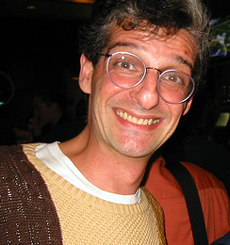Sunday, November 27, 2005
Quorum Sensing and the Blogosphere as a Superorganism
Heh! I always wanted to write this post. Being lazy is actually good sometimes. Just wait long enough and, lo and behold, someone else will write your post! Saves you time and energy.
Daniel Conover, whom I had great pleasure to meet in person at the ConvergeSouth conference, wrote a very thought-provoking post: Bacteria, blogs, holographic consciousness and The Singularity. There is a lot of biology there, but that is just a pretext for trying to understand what the Internet, and blogs in particular, are growing up to be. Perhaps something like a neural network? A collective consciousness? A superorganism? A hive?
While Daniel used bacterial communication, something usually called "quorum sensing", as the biological model for what the Internet is becoming, I was instantly reminded of the cellular slime mold. Those are single cells for most of the time. Then, when conditions are right, the cells start calling each other and aggregating. Together they form a mushroom-like structure with a head and a stalk. The cells in the head reproduce. The cells in the stalk do not - as good as suicide.
Dr. John Tyler Bonner has spent decades studying slime mold. Bonner, being a brilliant person, wrote a number of books on various topics, some technical, some much more easy to read. In his book Life Cycles, he explains the strange life cycle of the slime mold in great detail, and explains evolution in a wonderful manner. In his Evolution of Complexity he extends his insights from slime mold to animal and human communities (that was before Internet, though). His last book that he wrote around the time of his retirement 60 Years of Biology is just a wealth of ideas about evolution. While on Amazon, check his other books, too.
Why do I think slime mold may be a better model? Because an individual can live alone or join the multicellular structure. This reminds me of the human ability to log on and log off. When online and blogging, you are a part of a superorganism. When you get offline, you can be alone, or re-join a smaller superorganism - your family, neighborhood, friends, colleagues...
But, while you are offline, your blog and other online activities are still up there for others to see and use. You have donated some information to the superorganism without having to actually be there yourself. Even after you die, your information hangs on there.
What about people who never get online? They are affected by what goes on online, no matter how much they may try to stay away from it all. Rise and fall of individuals in politics and the media is often initiated online. Databases of all kinds are now online. Voting machines, if online, may easily be tampered with. No escape from the influence of the Internet. See what happened to the hero of bringing glasnost and democracy to Iran! A very, very chilling story! And don't forget Dooce.
How about defense mechanisms? Was the recent FEC decision (stating that blogs are media) influenced by the outrage by bloggers from both Left and Right? A cancerous cell does not follow the rules and the organism deploys various defense tactics against it. How does the Internet defend itself against the equivalent - splogs, for instance? Or someone like Paul Deignan who does not play by the rules and is now getting shunned, screaming from his blog into the empty wilderness while nobody is listening to him any more?
Then, there is another question - is there just one superorganism, or two, or many? How much cross-polination really happens between political Left and political Right, between personal diarists and techno-geeks, between English-language blogs and Chinese-language blogs? All those mini-blogospheres live pretty much independent lives. Yes, there is a little bit of cross-polination, but not more than, for instance, horizontal transfer of genetic material via viruses. There is definitely mutual influence between different realms, and even co-dependence (where would all of us be without techno-geeks who designed all the software we use, and who would they sell their programs to, if nobody else cared to write stuff on blogs?), but this reminds me more of different species in an ecosystem than of organs inside a single body.
How does this superoarganism evolve? Stuart Kauffman's book At home in the Universe is excellent at explaining how many little simple elements, when interacting together, build a whole that is bigger than the sum of its parts. His last chapter applies to economics in an interesting way (I used to hate that chapter and vehemently disagree, but I have come around), and the same model may be applied to the Internet.
Finally, when individuals join groups, and the groups bump inot other groups, then evolution operates with selection at both the individual and the group level. To learn more about selection at the level of the group, the place to go is Unto Others, a book by Elliott Sober and David Sloan Wilson. The first half explains how group selection works and gives examples from lab and field. The second half applies the model to the question of the evolution of human altruism. Wilson followed this up with another book, Darwin's Cathedral, applying group-selection thinking to the problem of evolution and adaptive function of religion.
Please go to Daniel's post for further discussion....




















